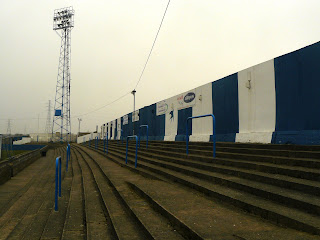The contents will include a mixture of written texts, visual scores and photographs. These may be bound in separate sections and held together in a hard jacket similar to a library-bound musical score. Other possible formats include that of a broadsheet newspaper to be handed out at matches, following in the foot steps of the little-known journal Jeder Mann Eigner Fussball (Every Man his Own Football)… ‘Walter Mehring claimed to be responsible for the unusual distribution methods used for ‘Jedermann Sein Eigner Fussball’, dated 15th Feb. 1919, costing 30 Pfennigs… “We hired a char-a-banc… and also a little band, complete with frock coats and top hats, ho used to play at ex-servicemen’s funerals. We, the editorial staff, paced behind, six strong, bearing bundles of Jedermann instead of wreaths. In the sophisticated west end of the city we earned more taunts than pennies, but our sales mounted sharply as we entered the lower-middle class districts of North and East Berlin.” This combined the ambition of a newspaper with the niche marketing of an artists’ book. However, it was surpressed immediately and remaining copies destroyed.'
From ‘Futurist Typography and the Liberated Text’ by Alan Bartram (British Library, 2005)
A comprehensive selection of dramatically titled, fan-produced books on the team can be found in Barrow reference library. These range from simple photocopied and stapled books to the more luxurious hard bound (in a uniform royal blue). Some of my favourites include:
- The Definitive Barrow FC. This one has a list of every player ever to play for the team.
- The Holker St. Greats Pt.2. Brilliantly concise statements summing up each player, such as: ‘Steve Brooks always gave 100%’, ‘Peter McDonnell, always a crowd favourite’, ‘Mick Richmond a popular attacking full back’, ‘Kevin Thomas the Jolly Juggler’ etc.
- Wembley 1990 FA Trophy Final – spiral bound scrapbook.
- The Colin Cowperthwaite Testimonial Programme
- A Dream Weekend
- Barrow AFC: In the Beginning There Was the End - BAFC: The Postwar Years has some excellent chapter headings:
The Saddest Season Ever, We Battle On, Pitch Ultimatum from League, Hughes Lasts 24 hrs Before McManus Steps in, 3,500 Witness City Thriller, Bring on the Wolves, Cup Dream Shattered, Two Out of Three In, Another Woeful Season, Gillingham’s Nightmare on Holker St., Vickers Steps in With Financial Help.
Another current influence is The Unfortunates by B.S Johnson. A sports journalist, sent to a Midlands town on a weekly assignment, finds himself confronted by ghosts from the past when he disembarks at the railway station and attempts to go about the routine business of reporting a football match. The book is contained in a box, with twenty seven sections presented, unbound, to be shuffled and read in whichever random order the reader happens to take them.
“And what would the ‘bleeding librarians” do to The Unfortunates, Johnson wondered. “Would they bind it up like a Proper Book, the sods?” Some did of course.’
Quote from ‘Futurist Typography and the Liberated Text’ by Alan Bartram (British Library, 2005)
Miscellaneous ideas:
- Produce a book printed on a series of microfiche films so that people have to go to the reference library in order to read it.
- Get fans and small children to draw portraits of every player who ever played for the team from imagination and compile them into sticker album.
- Make a special edition of the programme that is written entirely hand written / hand drawn.













